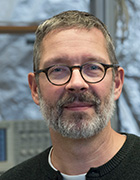
Prof. Dr. Harald Luksch
Academic Career and Research Areas
Prof. Luksch (b. 1965) has a background in neurobiology and explores sensory processing in the brains of vertebrates. His lab focuses on neuronal networks in the midbrain, a central area for the orientation of the body and sensory organs, e.g., eye movements. His goal is to gain a mechanistic understanding of processes such as object selection and the integration of multimodal stimuli, and to make these findings available as algorithms for technical applications.
After studying biology in Bonn (Magister 1990) and Cologne (doctorate 1994), Prof. Luksch conducted postdoctoral research in Bremen and San Diego. He earned his post-doctoral teaching qualification at RWTH Aachen (2002) and was appointed to the Chair of Zoology at TUM in 2007, where he heads the university’s interdisciplinary Leonardo da Vinci Center for Bionics. He also plays an active role in the Bernstein Center for Computational Neuroscience and the Graduate School for Systemic Neuroscience. Since 2016, he has been Dean of Studies for Biosciences at the TUM School of Life Sciences.
Key Publications (all publications)
Garrido-Charad, F, Vega-Zuniga, T., Gutiérrez-Ibáñez, C., Fernandez, P., Lopez-Jury, J., González-Cabrera, C., Karten, H.J., Luksch, H., Marin, G.J.: "Shepherd’s crook neurons drive and synchronize the enhancing and suppressive mechanisms of the midbrain stimulus selection network." PNAS 2018 (32), 7615 - 7623.
AbstractLischka, K., Ladel, S., Luksch, H., Weigel, S.: "Expression patterns of ion channels and structural proteins in a multimodal cell type of the avian optic tectum". J Comp Neurol.; 2018 526, 412-424.
AbstractSchnyder HA, Vanderelst D, Bartenstein S, Firzlaff U, Luksch H.: "The avian head induces cues for sound localization in elevation." PLoS One. 2014; 9(11):e112178.
AbstractHeyers D, Manns M, Luksch H, Güntürkün O, Mouritsen H: “A putative magnetosensory pathway in migratory birds.” PLOS One 2007; 2 (937).
AbstractLuksch H, Khanbabaie R, Wessel R: “Synaptic depression mediates form-cue invariant motion analysis”. Nature Neuroscience. 2004; 7: 380-388.
AbstractIf you wish your profile to be changed or updated please contact Franz Langer.